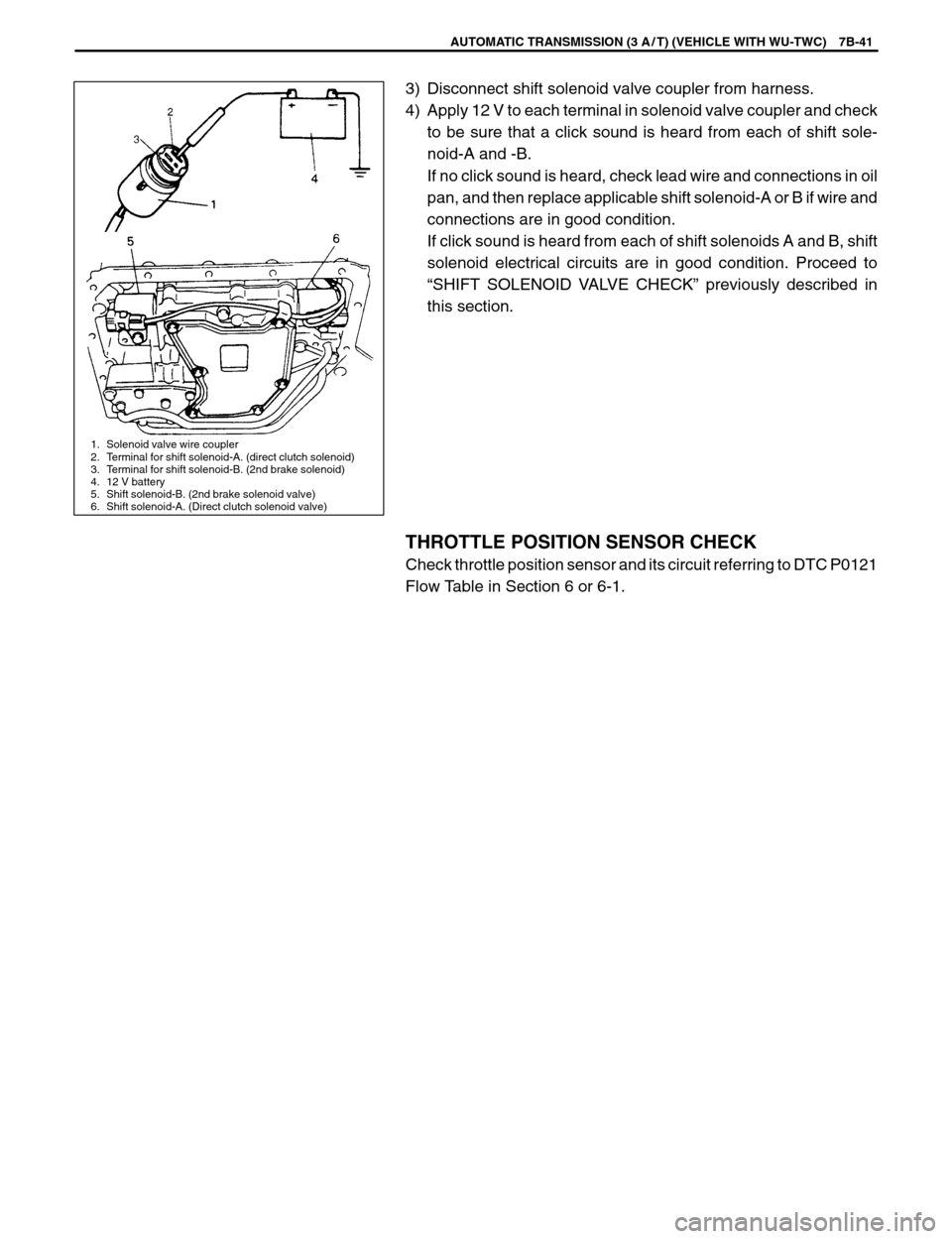Page 522 of 557

AUTOMATIC TRANSMISSION (3 A / T) (VEHICLE WITH WU-TWC) 7B-31
TABLE A-2 GEAR CHANGE FAILURE
STEPACTIONYESNO
1Was “AUTOMATIC TRANSMISSION DIAGNOSTIC
FLOW TABLE” performed?Go to Step 2.Go to “AUTOMATIC
TRANSMISSION
DIAGNOSTIC FLOW
TABLE”.
2Disconnect solenoid valve wire coupler and perform
manual road test.
Is upshift from 1st to 2nd possible?Go to Step 3.1-2 shift valve sticks
or Shift solenoid-B
(2nd brake solenoid)
valve sticks.
3Is upshift from 2nd to 3rd possible?Gear shift control
system defective.
Go to A / T Diagnostic
Flow Table B.2-3 shift valve sticks
or Shift solenoid-A
(Direct clutch
solenoid) valve
sticks.
TABLE A-3 EXCESSIVE SHOCK AT RANGE SELECTION OR GEAR CHANGE
STEPACTIONYESNO
1Was “AUTOMATIC TRANSMISSION DIAGNOSTIC
FLOW TABLE” performed?Go to Step 2.Go to “AUTOMATIC
TRANSMISSION
DIAGNOSTIC FLOW
TABLE”.
2Is line pressure proper?Go to Step 3.Regulator valve
defective, Throttle
valve defective or
Accelerator cable
maladjusted.
3Does excessive shock occur when selecting “D” range
from “N” range?Forward clutch
accumulator
operation failure,
Forward clutch worn
or Forward clutch oil
circuit check ball
operation failure. Go to Step 4.
4Does excessive shock occur when selecting “R” range
from “N” range?1st-Reverse brake
worn, 1st-Reverse
brake oil circuit check
ball operation failure.Go to Step 5.
5Does excessive shock occur at 1st to 2nd gear
change?2nd brake
accumulator
defective, 2nd brake
worn, 2nd brake oil
circuit check ball
operation failure.In case of excessive
shock at 2nd to 3rd
gear change, Direct
clutch worn or Direct
clutch oil circuit check
ball operation failure.
Page 525 of 557

1. Drive shaft (LH)
2. Oil pan
7B-34 AUTOMATIC TRANSMISSION (3 A / T) (VEHICLE WITH WU-TWC)
9) Possible causes for out-of-specification line pressure are as
follows. Check each part which is suspected to be the cause.
Line pressure
Possible causes
Higher than specification
in D and R ranges�Regulator valve defective
�Throttle valve in valve body
defective
�Accelerator cable and oil
pressure control cable
maladjusted
Lower than specification
in D and R ranges�Oil pump defective
�Regulator valve defective
�Throttle valve in valve body
defective
�Accelerator cable and oil
pressure control cable
maladjusted
Lower than specification
only in D range�Forward clutch oil pressure
system oil leakage
�D range oil pressure system
oil leakage
Lower than specification
only in R range�Direct clutch oil pressure
system oil leakage
�1st-reverse brake oil
pressure system oil leakage
�R range oil pressure system
oil leakage
10) Reinstall plug and tighten it to specification.
Tightening Torque
(a): 7.5 N·m (0.75 kg-m, 5.5 lb-ft)
Page 526 of 557

AUTOMATIC TRANSMISSION (3 A / T) (VEHICLE WITH WU-TWC) 7B-35
ROAD TEST
This test is to check if upshift and downshift take place at specified
speeds while actually driving vehicle on a level road.
WARNING:
�Carry out the test in very little traffic area to prevent an ac-
cident.
�The test requires 2 persons, a driver and a tester.
1) Warm up engine.
2) With engine running at idle, shift selector lever to D range.
3) i) Accelerate vehicle speed by depressing accelerator pedal
very little (within 4 deg. of throttle valve opening).
ii) Check if upshift takes place from 1st to 2nd at about 18 km / h
(11 mile / h) and from 2nd to 3rd at about 30 km / h (19 mile / h).
iii)
[For G10 Engine Model]
Stop vehicle once. Then start it again and while accelerating
by depressing accelerator pedal fully, check if upshift takes
place from 1st to 2nd at 52 km / h (33 mile / h) and from 2nd to
3rd at 97 km / h (61 mile / h).
[For G13 Engine Model]
Stop vehicle once. Then start it again and while accelerating
by depressing accelerator pedal fully, check if upshift takes
place from 1st to 2nd at 58 km / h (36 mile / h) and from 2nd to
3rd at 110 km / h (69 mile / h).
iv) Stop vehicle again.
v) Start vehicle and keep it running at 25 km / h (15 mile / h) and
then release accelerator pedal completely. 1 or 2 seconds lat-
er, depress accelerator pedal fully and check if downshift
from 2nd to 1st takes place.
vi) Keep vehicle running at 75 km / h (47 miles / h) and in the
same way as in step v), check if downshift from 3rd to 2nd
takes place.
vii) If upshift or downshift fails to take place at each specified
speed in the road test, possible causes for such failure are as
follows. Check each part which is suspected to be the cause.
Condition
Possible causes
No upshift from 1st
to 2nd�1 – 2 shift valve defective
�2nd brake solenoid valve defective
�PCM defective, or disconnection or
poor connection in electric circuit
No upshift from
2nd to 3rd�2-3 shift valve defective
�Direct clutch solenoid valve defective
�PCM defective, or disconnection or
poor connection in electric circuit
No downshift from
2nd to 1st or 3rd to
2nd�Throttle position sensor defective
�PCM defective, or disconnection or
poor connection in electric circuit
Page 529 of 557

7B-38 AUTOMATIC TRANSMISSION (3 A / T) (VEHICLE WITH WU-TWC)
TABLE B-1 GEAR SHIFT FAILURE IN “D” OR “2” RANGE
STEPACTIONYESNO
1Was “TABLE A-2 GEAR CHANGE FAILURE” performed?Go to Step 2.Go to “TABLE
A-2”.
2Is gear no shift at all?Go to Step 3.Go to Step 4.
3Perform vehicle speed sensor check refer to “OUTPUT
SPEED SENSOR CHECK” in this section.
Is check result satisfactory?Go to Step 5.Repair or
replace.
4Perform throttle position sensor check referring to DTC P0121
Flow Table in Section 6-1.
Is check result satisfactory?Go to Step 5.Repair or
replace.
5Perform “SHIFT SOLENOID VALVE CIRCUIT CHECK”
described later in this section.
Is check result satisfactory?Substitute a
known-good
PCM and
recheck.Replace shift
solenoid-A
(direct clutch
solenoid) valve
or shift
solenoid-B (2nd
brake solenoid)
valve.
TABLE B-2 GEAR IS SHIFTED TO 2ND GEAR IN “L” RANGE
VEHICLE DOES NOT MOVE BACKWARD IN “R” RANGE
NOTE:
Gear shift to 2nd may occur when selector lever is shifted from D or 2 to L, but this is normal.
STEP
ACTIONYESNO
1Was “TABLE A-2 GEAR CHANGE FAILURE” performed?Go to Step 2.Go to “TABLE
A-2”.
2Perform “SHIFT SOLENOID VALVE CIRCUIT CHECK”
described later in this section.
Is check result satisfactory?Substitute a
known-good
PCM and
recheck.Replace shift
solenoid-A
(direct clutch
solenoid) valve
or shift
solenoid-B (2nd
brake solenoid)
valve.
Page 532 of 557

1. Solenoid valve wire coupler
2. Terminal for shift solenoid-A. (direct clutch solenoid)
3. Terminal for shift solenoid-B. (2nd brake solenoid)
4. 12 V battery
5. Shift solenoid-B. (2nd brake solenoid valve)
6. Shift solenoid-A. (Direct clutch solenoid valve)
AUTOMATIC TRANSMISSION (3 A / T) (VEHICLE WITH WU-TWC) 7B-41
3) Disconnect shift solenoid valve coupler from harness.
4) Apply 12 V to each terminal in solenoid valve coupler and check
to be sure that a click sound is heard from each of shift sole-
noid-A and -B.
If no click sound is heard, check lead wire and connections in oil
pan, and then replace applicable shift solenoid-A or B if wire and
connections are in good condition.
If click sound is heard from each of shift solenoids A and B, shift
solenoid electrical circuits are in good condition. Proceed to
“SHIFT SOLENOID VALVE CHECK” previously described in
this section.
THROTTLE POSITION SENSOR CHECK
Check throttle position sensor and its circuit referring to DTC P0121
Flow Table in Section 6 or 6-1.